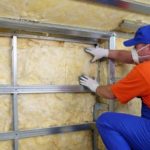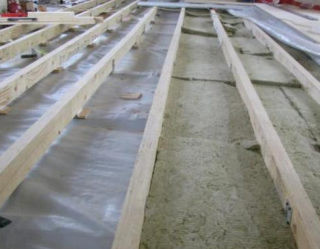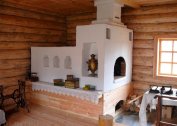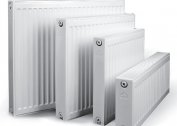There are two large groups of heaters - plate and roll. Each variety is used depending on operating conditions. Roll insulation is most effective when finishing long sections and complex structures. This is achieved due to the high density and flexibility of the material. The rolls are compact and easy to transport and store. The installation process itself also does not cause difficulties. The main thing is not to leave gaps between adjacent sheets of the heat insulator.
Mineral wool and varieties of insulation from it
The use of mineral wool in rolls for warming various structures has been widely used due to the excellent thermal insulation properties of the material and the simplicity of working with it, as well as other positive qualities: low weight, incombustibility and low cost.
Using mineral wool supplied in rolls, it is possible to quickly and easily insulate the floor or roof. However, for different cases, you should choose mineral wool with certain characteristics. The types of mineral wool include the following types of insulation:
- The structure of the basalt insulation supplied in compact rolls is the finest fiberglass. It is obtained by remelting rocks of mountain origin.
- The cheapest and still sought after variety is glass wool. The fibers of this insulation are made on the basis of glass industry wastes. It happens wall and roofing.
- From the waste of the metallurgical industry slag is made.
Basalt mineral wool in rolls is resistant to high temperatures, is not afraid of moisture, does not emit toxins when heated, has a small weight.
The peculiarity of glass wool lies in its incombustibility and high soundproofing properties. It is necessary to work with this material with gloves, goggles and a respirator to protect against fine glass dust. The downside is the lack of moisture resistance, so the insulation must be additionally protected from moisture, which is not always economically viable.
A feature of slag minvata roll is its low price and high heat and sound insulation properties. This type of rolled mineral wool insulation for walls has the highest density and weight.
Foil insulation
Foil insulation in rolls is a two-layer combined material. It consists of foamed polyethylene, polystyrene foam or cork, and the outer layer of polished foil. The combination of these two materials made it possible to create a light, thin and effective insulation for building envelopes on the inside of the premises. With its help, high-quality protection of the coating from UV rays and moisture is provided.
Foiled roll insulation is distinguished by the substrate material. The following varieties are on sale:
- With a backing made of polystyrene foam - the most popular, practical and inexpensive material. However, its thermal insulation properties are not as high as that of foamed polyethylene.
- With a foam backing made of lightweight porous material.
- With a cork backing - the most expensive and natural coating, with excellent heat and sound insulation properties.
The outer reflective layer is made of foil or metallized spraying. The second option has less reflection, but perfectly retains steam, so this material is relevant in rooms with high humidity. The spraying strength is less than that of foil.
The main advantages of foil-rolled polystyrene foam and other types of substrates with a reflective layer include the following:
- Small thickness and light weight.
- The ability to create an even coating, which is especially important when arranging a water floor, laying laminate and other floor coverings.
- Flexibility, thanks to which it is possible to insulate not only even, but also complex structures.
- Simple installation without frame device. Fastening is carried out using adhesive or mounting foam.
Foil thin substrates are indispensable for the installation of a warm water floor. Heating water or electric circuits are placed on top, and heat enters the top, into the room, and not down.
Interventional heat insulator and its features
A separate type of flexible insulation is designed to fill the voids in the interventional space of log and timber houses. A distinctive feature of the material is its small width, which facilitates the installation process. The material is made from natural raw materials - batting, jute, flax.
It is possible to use such thermal insulation in comfortable narrow rolls not only in the process of building a new house, but also after several months / years.
Purpose and use of roll insulation
Roll insulation is a universal material, therefore it can be used for a wide range of construction and finishing works.
Walls
Thin light heat-insulating material allows you to insulate, soundproof and level the walls for decoration with wallpaper or wall panels. The material is cut into individual sheets and glued to a cleaned dust-free wall. As glue, a composition with a cement content is used, which provides high adhesion to the base.
Pipes
Most often, foil insulation is used to warm the pipes of the underfloor heating system. It is laid on an even prepared base. Water circuits are fixed from above. During heating, thermal energy is reflected from the substrate and directed upward. Thus, heat losses through the lower floor are eliminated, and the system itself becomes economically viable and efficient.
Roof
The widespread use of roll insulation for roof insulation is associated with the complex design of the rafter system. This material is great for flat and pitched roofs.
Thin foil material is also used for insulation of building envelopes on loggias and balconies. With a sufficient area and height of the room, mineral wool is used, which is placed between the elements of the battens from the timber. Using a piece of foil insulation, you can make a reflective screen for a heating radiator.
- Minerals for roofing
- Glass wool for pipes
- Mineral wool for walls
Material of popular manufacturers
On sale there are materials from different manufacturers. There are leaders among them whose perfect quality has been proven over the years:
- Knauf. Mineral wool from a German manufacturer has low thermal conductivity and excellent sound insulation.
- Izover. Material from a French manufacturer of a wide range of applications, due to the thickness of 2 - 15 cm. There are options with a foil layer.
- Ursa. The material has a long service life and excellent noise insulation properties.Does not burn and does not emit toxins when heated, has elasticity. It is used in private homes and industrial facilities.
Penofol and Topizol also belong to foil materials.
When choosing a heater, the requirements for thermal insulation of the room and operating conditions should be taken into account. Not all materials have moisture resistance, so they need additional protection with waterproofing materials.










